Module11 Body language 模块表格式教学设计
文档属性
| 名称 | Module11 Body language 模块表格式教学设计 | 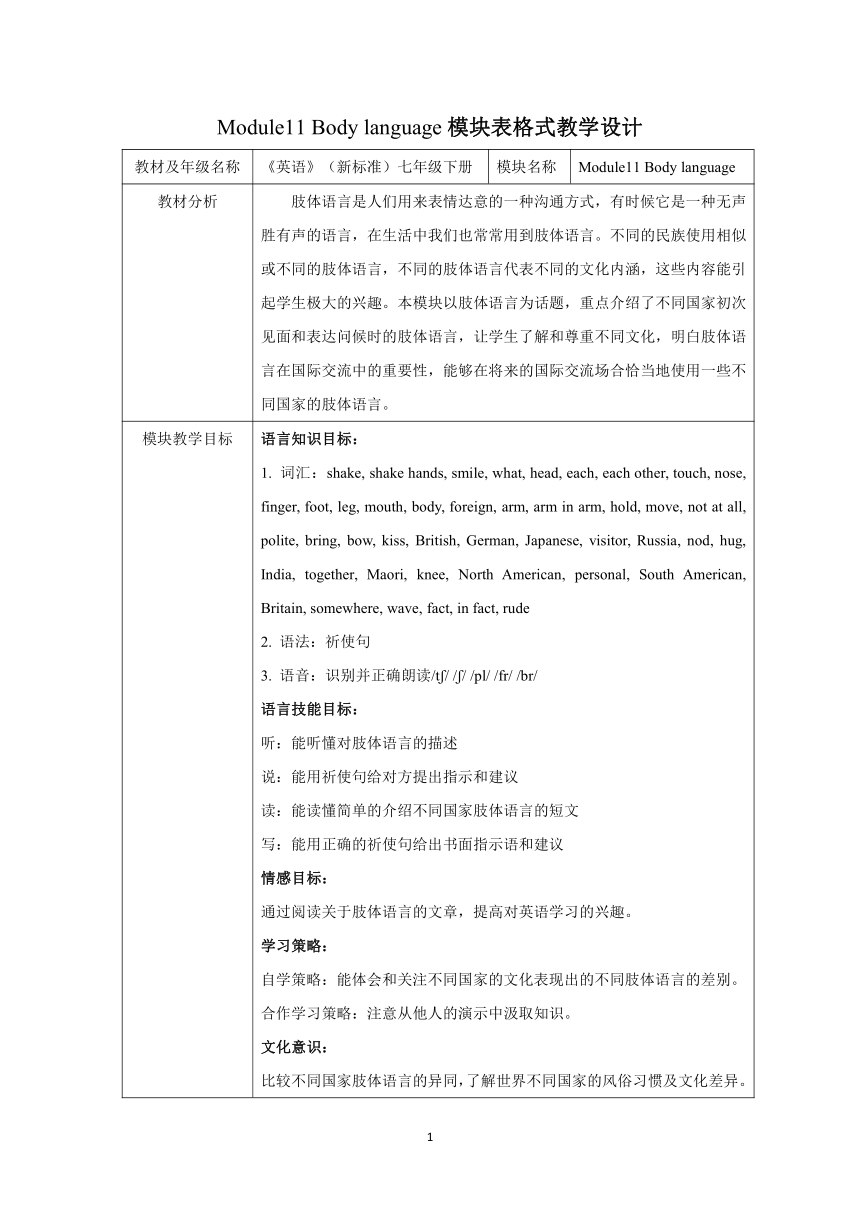 | |
| 格式 | doc | ||
| 文件大小 | 360.5KB | ||
| 资源类型 | 教案 | ||
| 版本资源 | 外研版 | ||
| 科目 | 英语 | ||
| 更新时间 | 2023-01-03 13:29:38 | ||
图片预览

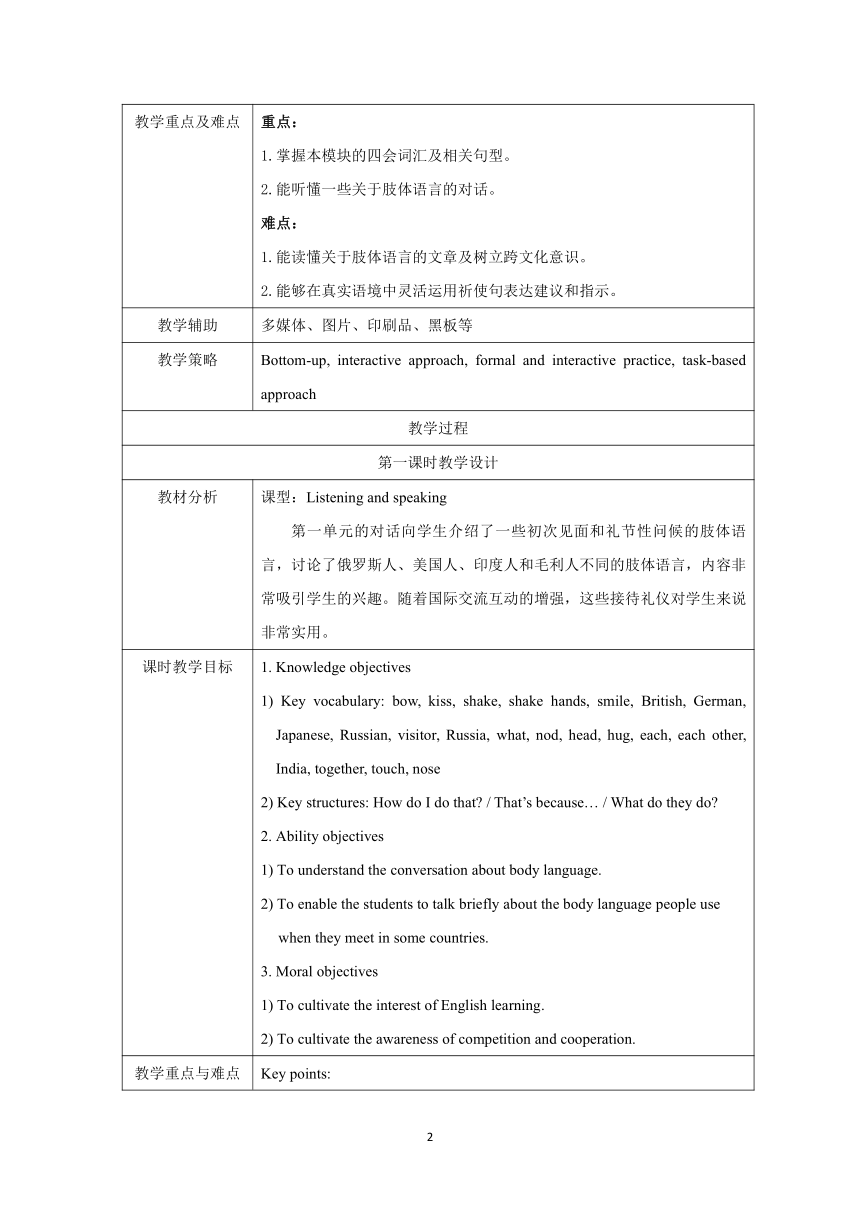
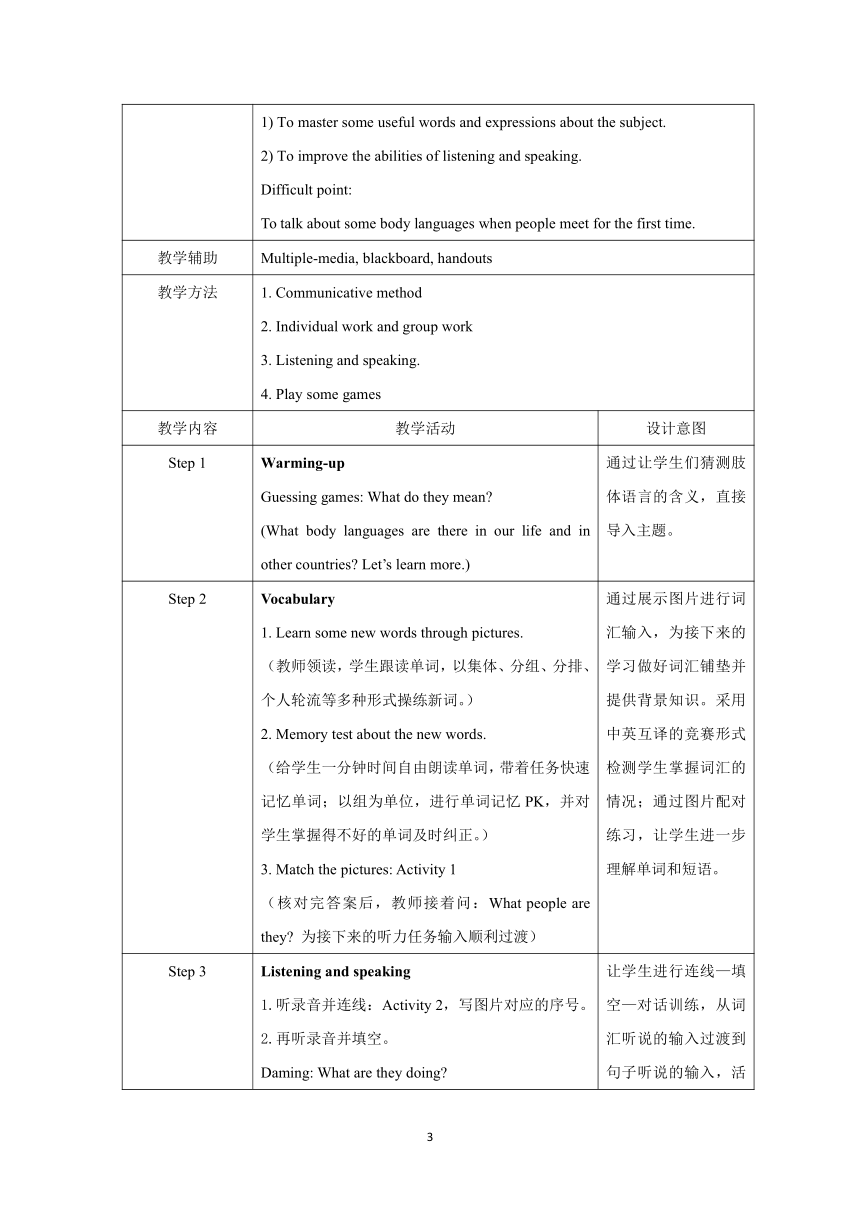
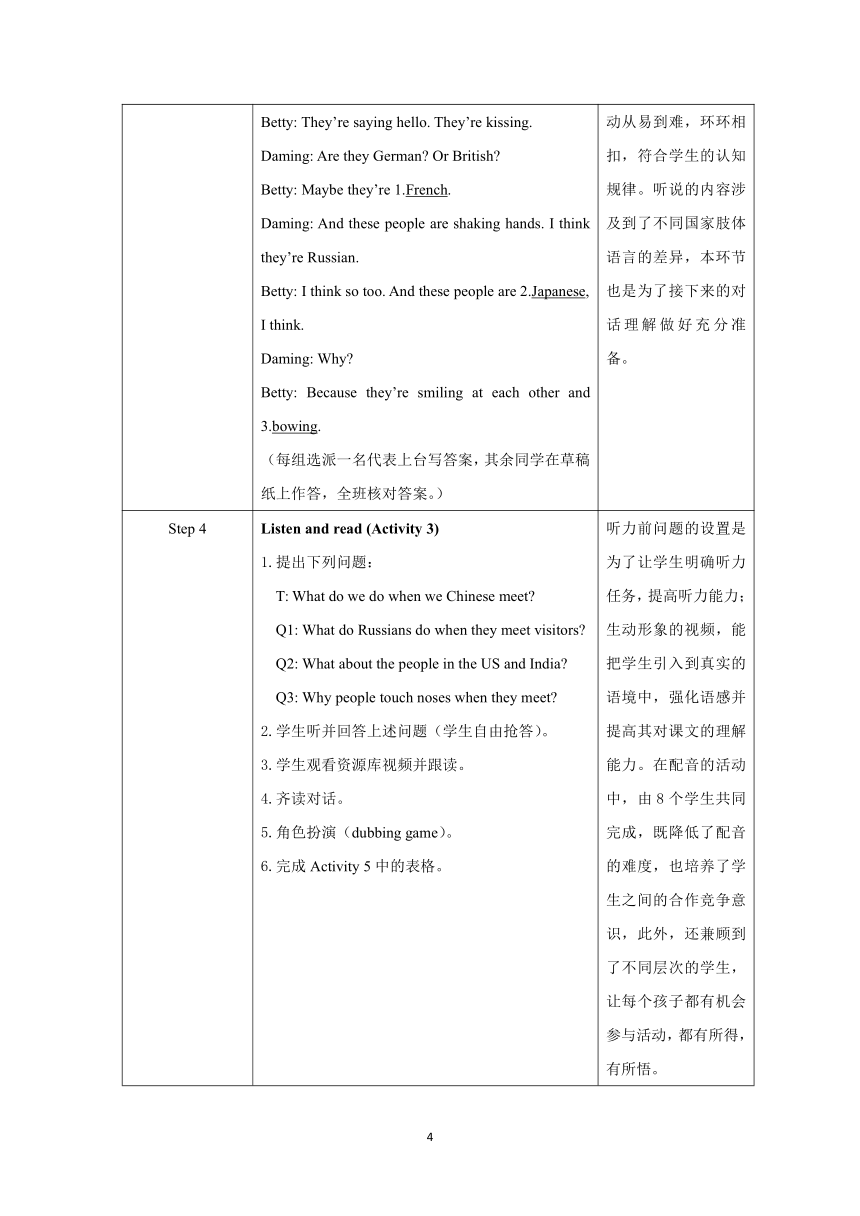
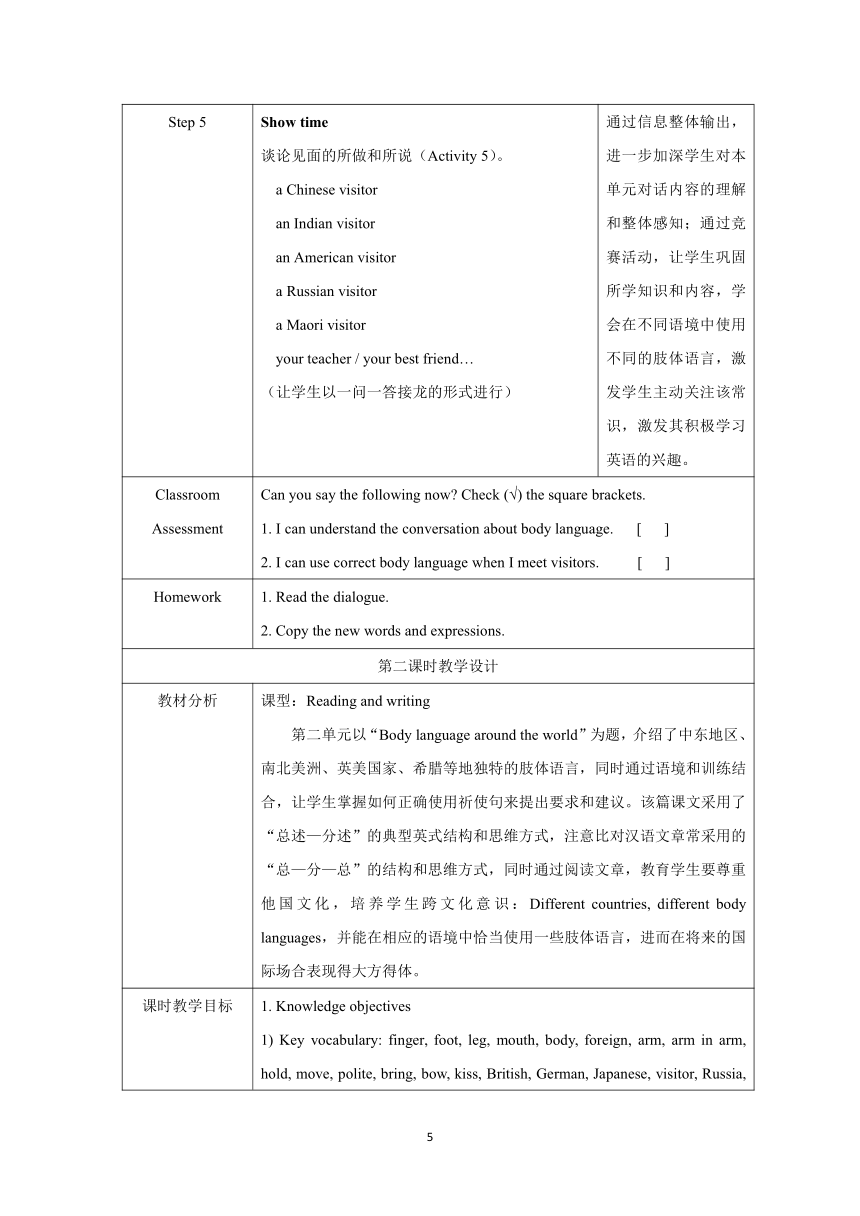
文档简介
Module11 Body language模块表格式教学设计
教材及年级名称 《英语》(新标准)七年级下册 模块名称 Module11 Body language
教材分析 肢体语言是人们用来表情达意的一种沟通方式,有时候它是一种无声胜有声的语言,在生活中我们也常常用到肢体语言。不同的民族使用相似或不同的肢体语言,不同的肢体语言代表不同的文化内涵,这些内容能引起学生极大的兴趣。本模块以肢体语言为话题,重点介绍了不同国家初次见面和表达问候时的肢体语言,让学生了解和尊重不同文化,明白肢体语言在国际交流中的重要性,能够在将来的国际交流场合恰当地使用一些不同国家的肢体语言。
模块教学目标 语言知识目标:1. 词汇:shake, shake hands, smile, what, head, each, each other, touch, nose, finger, foot, leg, mouth, body, foreign, arm, arm in arm, hold, move, not at all, polite, bring, bow, kiss, British, German, Japanese, visitor, Russia, nod, hug, India, together, Maori, knee, North American, personal, South American, Britain, somewhere, wave, fact, in fact, rude 2. 语法:祈使句3. 语音:识别并正确朗读/t / / / /pl/ /fr/ /br/ 语言技能目标:听:能听懂对肢体语言的描述说:能用祈使句给对方提出指示和建议读:能读懂简单的介绍不同国家肢体语言的短文写:能用正确的祈使句给出书面指示语和建议情感目标:通过阅读关于肢体语言的文章,提高对英语学习的兴趣。学习策略:自学策略:能体会和关注不同国家的文化表现出的不同肢体语言的差别。合作学习策略:注意从他人的演示中汲取知识。文化意识:比较不同国家肢体语言的异同,了解世界不同国家的风俗习惯及文化差异。
教学重点及难点 重点:1.掌握本模块的四会词汇及相关句型。2.能听懂一些关于肢体语言的对话。难点:1.能读懂关于肢体语言的文章及树立跨文化意识。2.能够在真实语境中灵活运用祈使句表达建议和指示。
教学辅助 多媒体、图片、印刷品、黑板等
教学策略 Bottom-up, interactive approach, formal and interactive practice, task-based approach
教学过程
第一课时教学设计
教材分析 课型:Listening and speaking第一单元的对话向学生介绍了一些初次见面和礼节性问候的肢体语言,讨论了俄罗斯人、美国人、印度人和毛利人不同的肢体语言,内容非常吸引学生的兴趣。随着国际交流互动的增强,这些接待礼仪对学生来说非常实用。
课时教学目标 1. Knowledge objectives1) Key vocabulary: bow, kiss, shake, shake hands, smile, British, German, Japanese, Russian, visitor, Russia, what, nod, head, hug, each, each other, India, together, touch, nose2) Key structures: How do I do that / That’s because… / What do they do 2. Ability objectives 1) To understand the conversation about body language.2) To enable the students to talk briefly about the body language people use when they meet in some countries.3. Moral objectives 1) To cultivate the interest of English learning.2) To cultivate the awareness of competition and cooperation.
教学重点与难点 Key points: 1) To master some useful words and expressions about the subject.2) To improve the abilities of listening and speaking.Difficult point: To talk about some body languages when people meet for the first time.
教学辅助 Multiple-media, blackboard, handouts
教学方法 1. Communicative method2. Individual work and group work3. Listening and speaking. 4. Play some games
教学内容 教学活动 设计意图
Step 1 Warming-up Guessing games: What do they mean (What body languages are there in our life and in other countries Let’s learn more.) 通过让学生们猜测肢体语言的含义,直接导入主题。
Step 2 Vocabulary1. Learn some new words through pictures.(教师领读,学生跟读单词,以集体、分组、分排、个人轮流等多种形式操练新词。)2. Memory test about the new words.(给学生一分钟时间自由朗读单词,带着任务快速记忆单词;以组为单位,进行单词记忆PK,并对学生掌握得不好的单词及时纠正。)3. Match the pictures: Activity 1(核对完答案后,教师接着问:What people are they 为接下来的听力任务输入顺利过渡) 通过展示图片进行词汇输入,为接下来的学习做好词汇铺垫并提供背景知识。采用中英互译的竞赛形式检测学生掌握词汇的情况;通过图片配对练习,让学生进一步理解单词和短语。
Step 3 Listening and speaking 1.听录音并连线:Activity 2,写图片对应的序号。2.再听录音并填空。Daming: What are they doing Betty: They’re saying hello. They’re kissing.Daming: Are they German Or British Betty: Maybe they’re 1.French.Daming: And these people are shaking hands. I think they’re Russian. Betty: I think so too. And these people are 2.Japanese, I think.Daming: Why Betty: Because they’re smiling at each other and 3.bowing. (每组选派一名代表上台写答案,其余同学在草稿纸上作答,全班核对答案。) 让学生进行连线—填空—对话训练,从词汇听说的输入过渡到句子听说的输入,活动从易到难,环环相扣,符合学生的认知规律。听说的内容涉及到了不同国家肢体语言的差异,本环节也是为了接下来的对话理解做好充分准备。
Step 4 Listen and read (Activity 3)1.提出下列问题:T: What do we do when we Chinese meet Q1: What do Russians do when they meet visitors Q2: What about the people in the US and India Q3: Why people touch noses when they meet 2.学生听并回答上述问题(学生自由抢答)。3.学生观看资源库视频并跟读。4.齐读对话。5.角色扮演(dubbing game)。 6.完成Activity 5中的表格。 听力前问题的设置是为了让学生明确听力任务,提高听力能力;生动形象的视频,能把学生引入到真实的语境中,强化语感并提高其对课文的理解能力。在配音的活动中,由8个学生共同完成,既降低了配音的难度,也培养了学生之间的合作竞争意识,此外,还兼顾到了不同层次的学生,让每个孩子都有机会参与活动,都有所得,有所悟。
Step 5 Show time谈论见面的所做和所说(Activity 5)。a Chinese visitoran Indian visitoran American visitora Russian visitora Maori visitoryour teacher / your best friend… (让学生以一问一答接龙的形式进行) 通过信息整体输出,进一步加深学生对本单元对话内容的理解和整体感知;通过竞赛活动,让学生巩固所学知识和内容,学会在不同语境中使用不同的肢体语言,激发学生主动关注该常识,激发其积极学习英语的兴趣。
Classroom Assessment Can you say the following now Check (√) the square brackets.1. I can understand the conversation about body language. [ ]2. I can use correct body language when I meet visitors. [ ]
Homework 1. Read the dialogue.2. Copy the new words and expressions.
第二课时教学设计
教材分析 课型:Reading and writing第二单元以“Body language around the world”为题,介绍了中东地区、南北美洲、英美国家、希腊等地独特的肢体语言,同时通过语境和训练结合,让学生掌握如何正确使用祈使句来提出要求和建议。该篇课文采用了“总述—分述”的典型英式结构和思维方式,注意比对汉语文章常采用的“总—分—总”的结构和思维方式,同时通过阅读文章,教育学生要尊重他国文化,培养学生跨文化意识:Different countries, different body languages,并能在相应的语境中恰当使用一些肢体语言,进而在将来的国际场合表现得大方得体。
课时教学目标 1. Knowledge objectives1) Key vocabulary: finger, foot, leg, mouth, body, foreign, arm, arm in arm, hold, move, polite, bring, bow, kiss, British, German, Japanese, visitor, Russia, nod, hug, India, knee, personal, wave, fact, in fact, rude2) Key structures: …don’t stand too close to North Americans! / Give them more personal space. / …wave to say goodbye. / But be careful!2. Ability objectives 1) To understand the main idea of the passage.2) To use correct ways of body language to welcome foreigners.3) To understand imperative sentences.3. Moral objectives 1) To respect different culture. 2) To cultivate the awareness of competition and cooperation.
教学重点与难点 Key points: 1) To master some useful words and expressions about the subject.2) To improve the ability of reading. Difficult point: To be able to use imperative sentences correctly.
教学辅助 Multiple-media, blackboard
教学方法 PWP, task-based approach
教学内容 教学活动 设计意图
Step 1 一、Lead-in1.问候。2.伴随音乐“If you’re happy”(如果感到幸福你就拍拍手)跳舞。T: If we are happy, …(让学生说出刚才视频中听到的句子)What body parts are used to show “If we’re happy” Can you say other body parts in English Let’s learn more. 通过歌曲活动热身,让学生轻松快乐地融入课堂。教师设定语境进入本节课的主题,为新词的学习做好铺垫。
Step 2 二、Pre-reading1.生词:通过图片学习本单元的生词,采用不同方式操练新单词。2.单词连线(Activity 1)在限定时间内,让学生快速完成该练习,以抽查的形式检测不同层次的学生,如:How do you spell “finger” / Can you spell “mouth” .... 3.游戏:根据指令触摸身体不同部位。1) 首先教师发出指令,学生以集体、小组为单位照做。2) 学生充当教师角色,发出指令,指定小组或个人按照指令做,以竞赛的形式开展该活动。(T: Our body language can show many meanings. How to welcome foreign friends Let’s learn more.) 词汇的学习为短文的阅读打下基础,通过触摸身体部位的游戏,让每个学生都能动起来,同时巩固所学单词,帮助他们更好地理解各个身体部位在肢体语言中的使用及含义。
Step 3 三、While-reading1. 快速阅读:把主要意思和段落连线。Para. 1 a. How about touching peoplePara. 2 b. Some ways to welcome foreignersPara. 3 c. How close we stand when talkingPara. 4 d. How to say goodbyePara. 5 e. Whether to look at people while talkingT: Would you like to know more details 2. Careful reading(1) 阅读课文第二、三段并填表。(2) 阅读课文第四、五段并回答问题。Do people in Britain look at each other when they talk How do we usually say goodbye Is it right to wave to say goodbye in Greece 3. 观看课文卡通视频,然后完成Activity 4。 通过快速阅读,培养学生快速获取信息的能力。在细节性阅读环节采取分段阅读,设置不同形式的阅读任务,提高学生的阅读技巧并增添阅读的乐趣。课文中的视频直观生动,让人记忆深刻,有助于学生进一步熟悉课文内容和知识结构。
Step 4 After-reading1.课文复述(借助图片)With the beginning: Here are some ways to welcome foreigners. How close do you stand when you talk to a friend people in Middle Eaststand close to…but don’t… North Americanspersonal spaceHow about touching people Chinese girlswalk arm in armSouth Americans… hold arm But in Britain many people don’t like…Do you look at people when you talk In some places, it isn’t polite to…; In other countries, … look somewhere else. In Britain and the US, people usually… And how do you say goodbye …wave to say goodbye… But be…in Greece. In fact, it’s very rude. 2.竞赛(操练祈使句)Make a list of class rules in the school by using imperative sentences.Like this: Do sth. / Don’t do sth.1) 以组为单位,集体讨论后,根据本班实际情况,用祈使句形式列举本班规则,内容包含dos and don’ts。2) 5分钟后,每组派代表展示作品,在规定的时间内写的规则最多者获胜。3) 学生点评作品。 从上个环节到这个环节的教学,以整进整出的形式输入输出知识,培养学生整体感知语言的能力和概括语言的能力。复述课文是提高学生综合运用语言能力的一种训练,这也是学习语言和我们的教学目标之一。复述内容设计要有梯度,应尽量兼顾不同层次学生的需求。单纯的语法操练会让学生感到枯燥无味,结合学生的实际情况,让学生用祈使句列举班级规则,会让学生感到兴趣盎然。通过学生之间的竞争和互评,让学生在竞争中学习,在学习中合作,在合作中共赢和进步。
Classroom Assessment Can you say the following now Check (√) the square brackets.1. I can understand the passage about body language. [ ]2. I can use imperative sentences to offer orders and suggestions. [ ]
Homework 1. Read the text fluently. 2. Make a list of your family rules.
第三课时教学设计
教材分析 课型:Revision and application 本单元主要是复习肢体语言的相关知识,以及对使用祈使句来提出要求和建议的语法知识的练习,而Around the world专栏介绍了日本人鞠躬礼的背景知识,对于日本人的鞠躬礼,学生普遍会有印象,教师应引导学生更多地了解各国风俗,鼓励他们走向国际文化,尊重他国文化,为将来的交流储备知识。
课时教学目标 1. Knowledge objectives1) To understand how to use body language to greet each other.2) To summarize and consolidate the use of imperative sentences.2. Ability objectives To be able to make suggestions by using imperative sentences.
教学重点与难点 Key points:1) To understand how to use body language to greet each other.2) To summarize and consolidate the use of imperative sentences.Difficult point:To be able to make suggestions by using imperative sentences.
教学辅助 Multiple-media, blackboard
教学方法 Formal and interactive practice, grammar practice and application, task-based approach
教学内容 教学活动 设计意图
Step 1 Lead-in 接龙游戏:用祈使句列举学校的规则。e.g. T: Don’t be late for school. / Listen carefully in class.S1: Don’t play basketball in the classroom.S2: Keep quiet in the library.S3: … 初一的学生天性活泼好动,游戏的形式可以充分调动学生学习的积极性和学习兴趣,让学生在轻松愉快的氛围中掌握知识。游戏内容紧扣本模块的教学目标,在游戏中,可以让学生复习巩固本模块所学的重点词汇、肢体语言常识,也为祈使句的语法知识做准备。
Step 2 二、Grammar practice(一)语法:祈使句。1.让学生观察模块语言展示部分中的句子。Give them more personal space.Wave to say goodbye.Be careful!Don’t stand too close to North Americans.…2.让学生自己先归纳总结,老师对祈使句再做补充。祈使句的定义(略讲)和结构(详讲),祈使句的结构是本节课要突破的重点和难点。3.通过练习,让学生掌握祈使句的运用。1) 完成PPT上的练习。2) Do Activity 1,该活动用口头表达形式操练。a. 全班朗读表格中的句子。b. 以竞赛的形式复述刚才表格中提到的关于英国的注意事项。c. 每组派一名代表进行口头展示。3) Do Activity 2,该活动用笔头表达形式操练。a. 集体动笔,合上课本,比一比谁的记忆力最好。b. 在规定时间内,将刚才表格中的注意事项凭个人记忆写下来。c. 展示部分优秀作品。(二)Activity 3:把句子改写成意思相同的祈使句。1.集体动笔,完成祈使句的转化。2.请部分学生上台书写答案,其余同学互相核对答案。3.全班核对答案,同时关注是否有错误率较高的题目,重点讲评。(三)Activity 4:使用括号内的词汇回答问题。1.让学生集体朗读方框内的单词,并要求写出其对应的中文。2.两人一组,学生之间互相问答。3.不同组别的学生进行两人挑战赛,回答正确者获胜。4.全班核对答案,做好查漏补缺准备。 祈使句在本模块Unit 2的教学中已经有所涉及,但是还没有较系统地进行语法知识呈现。因此,让学生观察已经学过的例句,加以分析,进行归纳总结,得出一个关于祈使句概括性的结论。通过教师对祈使句语法知识点的补充,让学生对该知识点的认识系统化、全面化,配合有梯度、有目的的语法练习,做到“重点突出,难点突破,语法点练透”,这样才能收到更好的教学效果。从Activity 1到Activity 4这四个活动,旨在巩固学生的基础知识,强化其对祈使句肯定和否定形式的运用,巩固其对本单元重点词汇和短语的理解、运用。在Activity 2活动中,要求学生比拼记忆力,写一写在英国的注意事项,虽然难度增加了,但能更大程度地激发学生的潜在学习力,并锻炼其思维能力。
Step 3 三、Around the world: The Japanese bow1.让全班齐读一遍该内容。2.回答以下问题。1) What body language is referred in this passage 2) What does the Japanese bow mean 本部分内容介绍的是日本人的鞠躬礼仪,学生对此不陌生。教师应引导学生尊重他国文化和习俗,鼓励学生更多地了解他国文化和风俗,以备将来交流场合之需。
Step 4 四、Module task: 1. Activity 5: Talk about different ways of saying hello and body language in China. 1) 教师可根据学生的实际情况,让学生提前收集资料。2) 分组进行讨论,教师给予适当帮助,帮助学生用英语来表达讨论的内容。3) 请小组代表口头陈述讨论结果。2. Talk about the local body language in your hometown.根据实际情况,可把制作海报的任务改为谈论自己家乡的肢体语言的活动。 活动5是本模块知识的延伸和拓展,采用小组讨论的形式,介绍中国本土文化中肢体语言的相关信息,鼓励学生学好英语,这样他们才有更多机会把中国文化推向世界。
Classroom Assessment 一、课堂学习效果评估Can you say the following now Check (√) the square brackets.1. I can tell a visitor what to do in a Chinese home. [ ]2. I can give dos and don’ts to others [ ] 3. I can tell how people greet each other in some countries. [ ] 二、一分钟问题1. Do you know body language is different in different countries 2. Can you understand some dos and don’ts in some foreign countries 3. Can you write dos and don’ts for others
Homework 1. Write the rules in the library / in the lab / in your family… by using imperative sentences. (自选其中一个)2. Collect the body language we have learnt.
PAGE
13
教材及年级名称 《英语》(新标准)七年级下册 模块名称 Module11 Body language
教材分析 肢体语言是人们用来表情达意的一种沟通方式,有时候它是一种无声胜有声的语言,在生活中我们也常常用到肢体语言。不同的民族使用相似或不同的肢体语言,不同的肢体语言代表不同的文化内涵,这些内容能引起学生极大的兴趣。本模块以肢体语言为话题,重点介绍了不同国家初次见面和表达问候时的肢体语言,让学生了解和尊重不同文化,明白肢体语言在国际交流中的重要性,能够在将来的国际交流场合恰当地使用一些不同国家的肢体语言。
模块教学目标 语言知识目标:1. 词汇:shake, shake hands, smile, what, head, each, each other, touch, nose, finger, foot, leg, mouth, body, foreign, arm, arm in arm, hold, move, not at all, polite, bring, bow, kiss, British, German, Japanese, visitor, Russia, nod, hug, India, together, Maori, knee, North American, personal, South American, Britain, somewhere, wave, fact, in fact, rude 2. 语法:祈使句3. 语音:识别并正确朗读/t / / / /pl/ /fr/ /br/ 语言技能目标:听:能听懂对肢体语言的描述说:能用祈使句给对方提出指示和建议读:能读懂简单的介绍不同国家肢体语言的短文写:能用正确的祈使句给出书面指示语和建议情感目标:通过阅读关于肢体语言的文章,提高对英语学习的兴趣。学习策略:自学策略:能体会和关注不同国家的文化表现出的不同肢体语言的差别。合作学习策略:注意从他人的演示中汲取知识。文化意识:比较不同国家肢体语言的异同,了解世界不同国家的风俗习惯及文化差异。
教学重点及难点 重点:1.掌握本模块的四会词汇及相关句型。2.能听懂一些关于肢体语言的对话。难点:1.能读懂关于肢体语言的文章及树立跨文化意识。2.能够在真实语境中灵活运用祈使句表达建议和指示。
教学辅助 多媒体、图片、印刷品、黑板等
教学策略 Bottom-up, interactive approach, formal and interactive practice, task-based approach
教学过程
第一课时教学设计
教材分析 课型:Listening and speaking第一单元的对话向学生介绍了一些初次见面和礼节性问候的肢体语言,讨论了俄罗斯人、美国人、印度人和毛利人不同的肢体语言,内容非常吸引学生的兴趣。随着国际交流互动的增强,这些接待礼仪对学生来说非常实用。
课时教学目标 1. Knowledge objectives1) Key vocabulary: bow, kiss, shake, shake hands, smile, British, German, Japanese, Russian, visitor, Russia, what, nod, head, hug, each, each other, India, together, touch, nose2) Key structures: How do I do that / That’s because… / What do they do 2. Ability objectives 1) To understand the conversation about body language.2) To enable the students to talk briefly about the body language people use when they meet in some countries.3. Moral objectives 1) To cultivate the interest of English learning.2) To cultivate the awareness of competition and cooperation.
教学重点与难点 Key points: 1) To master some useful words and expressions about the subject.2) To improve the abilities of listening and speaking.Difficult point: To talk about some body languages when people meet for the first time.
教学辅助 Multiple-media, blackboard, handouts
教学方法 1. Communicative method2. Individual work and group work3. Listening and speaking. 4. Play some games
教学内容 教学活动 设计意图
Step 1 Warming-up Guessing games: What do they mean (What body languages are there in our life and in other countries Let’s learn more.) 通过让学生们猜测肢体语言的含义,直接导入主题。
Step 2 Vocabulary1. Learn some new words through pictures.(教师领读,学生跟读单词,以集体、分组、分排、个人轮流等多种形式操练新词。)2. Memory test about the new words.(给学生一分钟时间自由朗读单词,带着任务快速记忆单词;以组为单位,进行单词记忆PK,并对学生掌握得不好的单词及时纠正。)3. Match the pictures: Activity 1(核对完答案后,教师接着问:What people are they 为接下来的听力任务输入顺利过渡) 通过展示图片进行词汇输入,为接下来的学习做好词汇铺垫并提供背景知识。采用中英互译的竞赛形式检测学生掌握词汇的情况;通过图片配对练习,让学生进一步理解单词和短语。
Step 3 Listening and speaking 1.听录音并连线:Activity 2,写图片对应的序号。2.再听录音并填空。Daming: What are they doing Betty: They’re saying hello. They’re kissing.Daming: Are they German Or British Betty: Maybe they’re 1.French.Daming: And these people are shaking hands. I think they’re Russian. Betty: I think so too. And these people are 2.Japanese, I think.Daming: Why Betty: Because they’re smiling at each other and 3.bowing. (每组选派一名代表上台写答案,其余同学在草稿纸上作答,全班核对答案。) 让学生进行连线—填空—对话训练,从词汇听说的输入过渡到句子听说的输入,活动从易到难,环环相扣,符合学生的认知规律。听说的内容涉及到了不同国家肢体语言的差异,本环节也是为了接下来的对话理解做好充分准备。
Step 4 Listen and read (Activity 3)1.提出下列问题:T: What do we do when we Chinese meet Q1: What do Russians do when they meet visitors Q2: What about the people in the US and India Q3: Why people touch noses when they meet 2.学生听并回答上述问题(学生自由抢答)。3.学生观看资源库视频并跟读。4.齐读对话。5.角色扮演(dubbing game)。 6.完成Activity 5中的表格。 听力前问题的设置是为了让学生明确听力任务,提高听力能力;生动形象的视频,能把学生引入到真实的语境中,强化语感并提高其对课文的理解能力。在配音的活动中,由8个学生共同完成,既降低了配音的难度,也培养了学生之间的合作竞争意识,此外,还兼顾到了不同层次的学生,让每个孩子都有机会参与活动,都有所得,有所悟。
Step 5 Show time谈论见面的所做和所说(Activity 5)。a Chinese visitoran Indian visitoran American visitora Russian visitora Maori visitoryour teacher / your best friend… (让学生以一问一答接龙的形式进行) 通过信息整体输出,进一步加深学生对本单元对话内容的理解和整体感知;通过竞赛活动,让学生巩固所学知识和内容,学会在不同语境中使用不同的肢体语言,激发学生主动关注该常识,激发其积极学习英语的兴趣。
Classroom Assessment Can you say the following now Check (√) the square brackets.1. I can understand the conversation about body language. [ ]2. I can use correct body language when I meet visitors. [ ]
Homework 1. Read the dialogue.2. Copy the new words and expressions.
第二课时教学设计
教材分析 课型:Reading and writing第二单元以“Body language around the world”为题,介绍了中东地区、南北美洲、英美国家、希腊等地独特的肢体语言,同时通过语境和训练结合,让学生掌握如何正确使用祈使句来提出要求和建议。该篇课文采用了“总述—分述”的典型英式结构和思维方式,注意比对汉语文章常采用的“总—分—总”的结构和思维方式,同时通过阅读文章,教育学生要尊重他国文化,培养学生跨文化意识:Different countries, different body languages,并能在相应的语境中恰当使用一些肢体语言,进而在将来的国际场合表现得大方得体。
课时教学目标 1. Knowledge objectives1) Key vocabulary: finger, foot, leg, mouth, body, foreign, arm, arm in arm, hold, move, polite, bring, bow, kiss, British, German, Japanese, visitor, Russia, nod, hug, India, knee, personal, wave, fact, in fact, rude2) Key structures: …don’t stand too close to North Americans! / Give them more personal space. / …wave to say goodbye. / But be careful!2. Ability objectives 1) To understand the main idea of the passage.2) To use correct ways of body language to welcome foreigners.3) To understand imperative sentences.3. Moral objectives 1) To respect different culture. 2) To cultivate the awareness of competition and cooperation.
教学重点与难点 Key points: 1) To master some useful words and expressions about the subject.2) To improve the ability of reading. Difficult point: To be able to use imperative sentences correctly.
教学辅助 Multiple-media, blackboard
教学方法 PWP, task-based approach
教学内容 教学活动 设计意图
Step 1 一、Lead-in1.问候。2.伴随音乐“If you’re happy”(如果感到幸福你就拍拍手)跳舞。T: If we are happy, …(让学生说出刚才视频中听到的句子)What body parts are used to show “If we’re happy” Can you say other body parts in English Let’s learn more. 通过歌曲活动热身,让学生轻松快乐地融入课堂。教师设定语境进入本节课的主题,为新词的学习做好铺垫。
Step 2 二、Pre-reading1.生词:通过图片学习本单元的生词,采用不同方式操练新单词。2.单词连线(Activity 1)在限定时间内,让学生快速完成该练习,以抽查的形式检测不同层次的学生,如:How do you spell “finger” / Can you spell “mouth” .... 3.游戏:根据指令触摸身体不同部位。1) 首先教师发出指令,学生以集体、小组为单位照做。2) 学生充当教师角色,发出指令,指定小组或个人按照指令做,以竞赛的形式开展该活动。(T: Our body language can show many meanings. How to welcome foreign friends Let’s learn more.) 词汇的学习为短文的阅读打下基础,通过触摸身体部位的游戏,让每个学生都能动起来,同时巩固所学单词,帮助他们更好地理解各个身体部位在肢体语言中的使用及含义。
Step 3 三、While-reading1. 快速阅读:把主要意思和段落连线。Para. 1 a. How about touching peoplePara. 2 b. Some ways to welcome foreignersPara. 3 c. How close we stand when talkingPara. 4 d. How to say goodbyePara. 5 e. Whether to look at people while talkingT: Would you like to know more details 2. Careful reading(1) 阅读课文第二、三段并填表。(2) 阅读课文第四、五段并回答问题。Do people in Britain look at each other when they talk How do we usually say goodbye Is it right to wave to say goodbye in Greece 3. 观看课文卡通视频,然后完成Activity 4。 通过快速阅读,培养学生快速获取信息的能力。在细节性阅读环节采取分段阅读,设置不同形式的阅读任务,提高学生的阅读技巧并增添阅读的乐趣。课文中的视频直观生动,让人记忆深刻,有助于学生进一步熟悉课文内容和知识结构。
Step 4 After-reading1.课文复述(借助图片)With the beginning: Here are some ways to welcome foreigners. How close do you stand when you talk to a friend people in Middle Eaststand close to…but don’t… North Americanspersonal spaceHow about touching people Chinese girlswalk arm in armSouth Americans… hold arm But in Britain many people don’t like…Do you look at people when you talk In some places, it isn’t polite to…; In other countries, … look somewhere else. In Britain and the US, people usually… And how do you say goodbye …wave to say goodbye… But be…in Greece. In fact, it’s very rude. 2.竞赛(操练祈使句)Make a list of class rules in the school by using imperative sentences.Like this: Do sth. / Don’t do sth.1) 以组为单位,集体讨论后,根据本班实际情况,用祈使句形式列举本班规则,内容包含dos and don’ts。2) 5分钟后,每组派代表展示作品,在规定的时间内写的规则最多者获胜。3) 学生点评作品。 从上个环节到这个环节的教学,以整进整出的形式输入输出知识,培养学生整体感知语言的能力和概括语言的能力。复述课文是提高学生综合运用语言能力的一种训练,这也是学习语言和我们的教学目标之一。复述内容设计要有梯度,应尽量兼顾不同层次学生的需求。单纯的语法操练会让学生感到枯燥无味,结合学生的实际情况,让学生用祈使句列举班级规则,会让学生感到兴趣盎然。通过学生之间的竞争和互评,让学生在竞争中学习,在学习中合作,在合作中共赢和进步。
Classroom Assessment Can you say the following now Check (√) the square brackets.1. I can understand the passage about body language. [ ]2. I can use imperative sentences to offer orders and suggestions. [ ]
Homework 1. Read the text fluently. 2. Make a list of your family rules.
第三课时教学设计
教材分析 课型:Revision and application 本单元主要是复习肢体语言的相关知识,以及对使用祈使句来提出要求和建议的语法知识的练习,而Around the world专栏介绍了日本人鞠躬礼的背景知识,对于日本人的鞠躬礼,学生普遍会有印象,教师应引导学生更多地了解各国风俗,鼓励他们走向国际文化,尊重他国文化,为将来的交流储备知识。
课时教学目标 1. Knowledge objectives1) To understand how to use body language to greet each other.2) To summarize and consolidate the use of imperative sentences.2. Ability objectives To be able to make suggestions by using imperative sentences.
教学重点与难点 Key points:1) To understand how to use body language to greet each other.2) To summarize and consolidate the use of imperative sentences.Difficult point:To be able to make suggestions by using imperative sentences.
教学辅助 Multiple-media, blackboard
教学方法 Formal and interactive practice, grammar practice and application, task-based approach
教学内容 教学活动 设计意图
Step 1 Lead-in 接龙游戏:用祈使句列举学校的规则。e.g. T: Don’t be late for school. / Listen carefully in class.S1: Don’t play basketball in the classroom.S2: Keep quiet in the library.S3: … 初一的学生天性活泼好动,游戏的形式可以充分调动学生学习的积极性和学习兴趣,让学生在轻松愉快的氛围中掌握知识。游戏内容紧扣本模块的教学目标,在游戏中,可以让学生复习巩固本模块所学的重点词汇、肢体语言常识,也为祈使句的语法知识做准备。
Step 2 二、Grammar practice(一)语法:祈使句。1.让学生观察模块语言展示部分中的句子。Give them more personal space.Wave to say goodbye.Be careful!Don’t stand too close to North Americans.…2.让学生自己先归纳总结,老师对祈使句再做补充。祈使句的定义(略讲)和结构(详讲),祈使句的结构是本节课要突破的重点和难点。3.通过练习,让学生掌握祈使句的运用。1) 完成PPT上的练习。2) Do Activity 1,该活动用口头表达形式操练。a. 全班朗读表格中的句子。b. 以竞赛的形式复述刚才表格中提到的关于英国的注意事项。c. 每组派一名代表进行口头展示。3) Do Activity 2,该活动用笔头表达形式操练。a. 集体动笔,合上课本,比一比谁的记忆力最好。b. 在规定时间内,将刚才表格中的注意事项凭个人记忆写下来。c. 展示部分优秀作品。(二)Activity 3:把句子改写成意思相同的祈使句。1.集体动笔,完成祈使句的转化。2.请部分学生上台书写答案,其余同学互相核对答案。3.全班核对答案,同时关注是否有错误率较高的题目,重点讲评。(三)Activity 4:使用括号内的词汇回答问题。1.让学生集体朗读方框内的单词,并要求写出其对应的中文。2.两人一组,学生之间互相问答。3.不同组别的学生进行两人挑战赛,回答正确者获胜。4.全班核对答案,做好查漏补缺准备。 祈使句在本模块Unit 2的教学中已经有所涉及,但是还没有较系统地进行语法知识呈现。因此,让学生观察已经学过的例句,加以分析,进行归纳总结,得出一个关于祈使句概括性的结论。通过教师对祈使句语法知识点的补充,让学生对该知识点的认识系统化、全面化,配合有梯度、有目的的语法练习,做到“重点突出,难点突破,语法点练透”,这样才能收到更好的教学效果。从Activity 1到Activity 4这四个活动,旨在巩固学生的基础知识,强化其对祈使句肯定和否定形式的运用,巩固其对本单元重点词汇和短语的理解、运用。在Activity 2活动中,要求学生比拼记忆力,写一写在英国的注意事项,虽然难度增加了,但能更大程度地激发学生的潜在学习力,并锻炼其思维能力。
Step 3 三、Around the world: The Japanese bow1.让全班齐读一遍该内容。2.回答以下问题。1) What body language is referred in this passage 2) What does the Japanese bow mean 本部分内容介绍的是日本人的鞠躬礼仪,学生对此不陌生。教师应引导学生尊重他国文化和习俗,鼓励学生更多地了解他国文化和风俗,以备将来交流场合之需。
Step 4 四、Module task: 1. Activity 5: Talk about different ways of saying hello and body language in China. 1) 教师可根据学生的实际情况,让学生提前收集资料。2) 分组进行讨论,教师给予适当帮助,帮助学生用英语来表达讨论的内容。3) 请小组代表口头陈述讨论结果。2. Talk about the local body language in your hometown.根据实际情况,可把制作海报的任务改为谈论自己家乡的肢体语言的活动。 活动5是本模块知识的延伸和拓展,采用小组讨论的形式,介绍中国本土文化中肢体语言的相关信息,鼓励学生学好英语,这样他们才有更多机会把中国文化推向世界。
Classroom Assessment 一、课堂学习效果评估Can you say the following now Check (√) the square brackets.1. I can tell a visitor what to do in a Chinese home. [ ]2. I can give dos and don’ts to others [ ] 3. I can tell how people greet each other in some countries. [ ] 二、一分钟问题1. Do you know body language is different in different countries 2. Can you understand some dos and don’ts in some foreign countries 3. Can you write dos and don’ts for others
Homework 1. Write the rules in the library / in the lab / in your family… by using imperative sentences. (自选其中一个)2. Collect the body language we have learnt.
PAGE
13
同课章节目录
- Module 1 Lost and found
- Unit 1 Whose bag is this?
- Unit 2 Are they yours?
- Unit 3 Language in use
- Module 2 What can you do ?
- Unit 1 I can play the piano
- Unit 2 I can run really fast
- Unit 3 Language in use
- Module 3 Making plans
- Unit 1 What are you going to do at the weekends?
- Unit 2 We're going to cheer the players.
- Unit 3 Language in use
- Module 4 Life in the future
- Unit 1 Everyone will study at home
- Unit 2 Every family will have a small plane.
- Unit 3 Language in use
- Module 5 Shopping
- Unit 1 What can I do for you?
- Unit 2 You can buy everything on the Internet
- Unit 3 Language in use
- Module 6 Around town
- Unit 1 Could you tell me how to get to the Nationa
- Unit 2 The London Eye is on your right.
- Unit 3 Language in use
- Revision module A
- Module 7 My past life
- Unit 1 I was born in a small village.
- Unit 2 I was born in Quincy.
- Unit 3 Language in use
- Module 8 Story time
- Unit 1 Once upon a time….
- Unit 2 Goldilocks hurried out of the house.
- Unit 3 Language in use
- Module 9 Life history
- Unit 1 He left school and began work at the age of
- Unit 2 He decided to be an actor.
- Unit 3 Language in use
- Module 10 A holiday journey
- Unit 1 What did you do?
- Unit 2 This morning we took a walk.
- Unit 3 Language in use
- Module 11 Body language
- Unit 1 They touch noses!
- Unit 2 Here are some ways to welcome them.
- Unit 3 Language in use
- Module 12 Western music
- Unit 1 It's so beautiful!
- Unit 2 Vienna is the centre of European classical
- Unit 3 Language in use
- Revision module B
